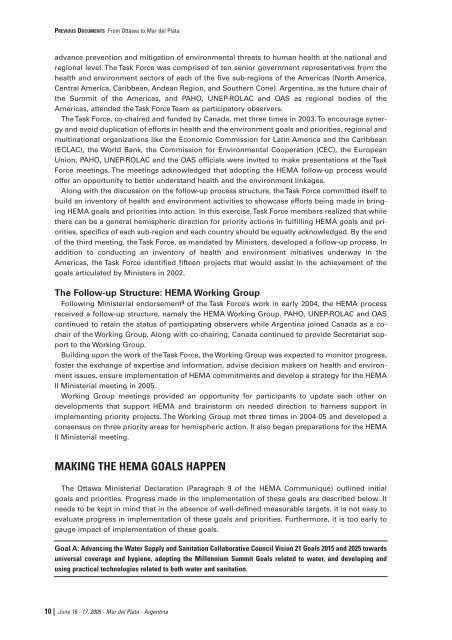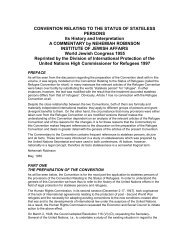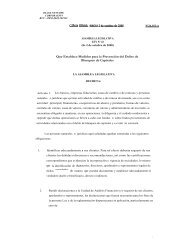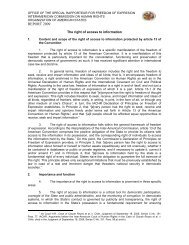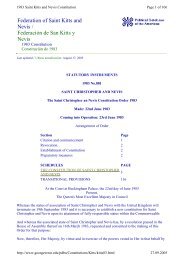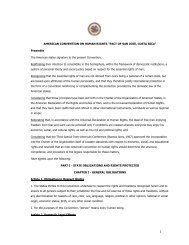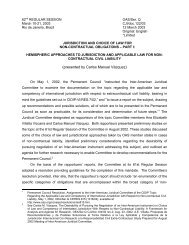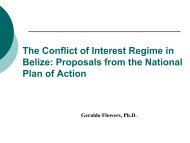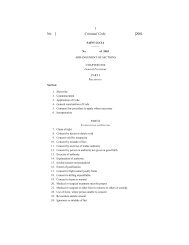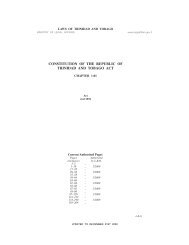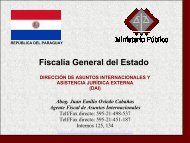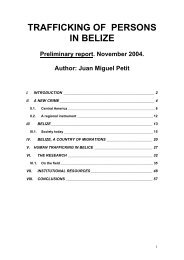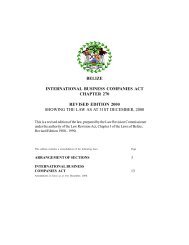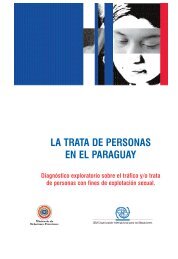(HEMA) Initiative. - OAS
(HEMA) Initiative. - OAS
(HEMA) Initiative. - OAS
Create successful ePaper yourself
Turn your PDF publications into a flip-book with our unique Google optimized e-Paper software.
PREVIOUS DOCUMENTS From Ottawa to Mar del Plata<br />
advance prevention and mitigation of environmental threats to human health at the national and<br />
regional level. The Task Force was comprised of ten senior government representatives from the<br />
health and environment sectors of each of the five sub-regions of the Americas (North America,<br />
Central America, Caribbean, Andean Region, and Southern Cone). Argentina, as the future chair of<br />
the Summit of the Americas, and PAHO, UNEP-ROLAC and <strong>OAS</strong> as regional bodies of the<br />
Americas, attended the Task Force Team as participatory observers.<br />
The Task Force, co-chaired and funded by Canada, met three times in 2003. To encourage synergy<br />
and avoid duplication of efforts in health and the environment goals and priorities, regional and<br />
multinational organizations like the Economic Commission for Latin America and the Caribbean<br />
(ECLAC), the World Bank, the Commission for Environmental Cooperation (CEC), the European<br />
Union, PAHO, UNEP-ROLAC and the <strong>OAS</strong> officials were invited to make presentations at the Task<br />
Force meetings. The meetings acknowledged that adopting the <strong>HEMA</strong> follow-up process would<br />
offer an opportunity to better understand health and the environment linkages.<br />
Along with the discussion on the follow-up process structure, the Task Force committed itself to<br />
build an inventory of health and environment activities to showcase efforts being made in bringing<br />
<strong>HEMA</strong> goals and priorities into action. In this exercise, Task Force members realized that while<br />
there can be a general hemispheric direction for priority actions in fulfilling <strong>HEMA</strong> goals and priorities,<br />
specifics of each sub-region and each country should be equally acknowledged. By the end<br />
of the third meeting, the Task Force, as mandated by Ministers, developed a follow-up process. In<br />
addition to conducting an inventory of health and environment initiatives underway in the<br />
Americas, the Task Force identified fifteen projects that would assist in the achievement of the<br />
goals articulated by Ministers in 2002.<br />
The Follow-up Structure: <strong>HEMA</strong> Working Group<br />
Following Ministerial endorsement 3 of the Task Force’s work in early 2004, the <strong>HEMA</strong> process<br />
received a follow-up structure, namely the <strong>HEMA</strong> Working Group. PAHO, UNEP-ROLAC and <strong>OAS</strong><br />
continued to retain the status of participating observers while Argentina joined Canada as a cochair<br />
of the Working Group. Along with co-chairing, Canada continued to provide Secretariat support<br />
to the Working Group.<br />
Building upon the work of the Task Force, the Working Group was expected to monitor progress,<br />
foster the exchange of expertise and information, advise decision makers on health and environment<br />
issues, ensure implementation of <strong>HEMA</strong> commitments and develop a strategy for the <strong>HEMA</strong><br />
II Ministerial meeting in 2005.<br />
Working Group meetings provided an opportunity for participants to update each other on<br />
developments that support <strong>HEMA</strong> and brainstorm on needed direction to harness support in<br />
implementing priority projects. The Working Group met three times in 2004-05 and developed a<br />
consensus on three priority areas for hemispheric action. It also began preparations for the <strong>HEMA</strong><br />
II Ministerial meeting.<br />
MAKING THE <strong>HEMA</strong> GOALS HAPPEN<br />
The Ottawa Ministerial Declaration (Paragraph 9 of the <strong>HEMA</strong> Communiqué) outlined initial<br />
goals and priorities. Progress made in the implementation of these goals are described below. It<br />
needs to be kept in mind that in the absence of well-defined measurable targets, it is not easy to<br />
evaluate progress in implementation of these goals and priorities. Furthermore, it is too early to<br />
gauge impact of implementation of these goals.<br />
Goal A: Advancing the Water Supply and Sanitation Collaborative Council Vision 21 Goals 2015 and 2025 towards<br />
universal coverage and hygiene, adopting the Millennium Summit Goals related to water, and developing and<br />
using practical technologies related to both water and sanitation.<br />
10 | June 16 - 17, 2005 - Mar del Plata - Argentina


